











 Price: [price_with_discount]
Price: [price_with_discount](as of [price_update_date] – Details)
 [ad_1]
10 inches x 10 inches, hardcover with flap, 112 pages
[ad_1]
10 inches x 10 inches, hardcover with flap, 112 pagesFull color photographs throughout, glossary, index
Praise for Creatures of the Deep: In Search of the Sea’s Monsters and the World They Live In:
“Erich Hoyt captures the excitement and beauty of recent advances [in ocean science]. With lavish photos and engaging, accurate prose, he takes readers on a journey of wonder through the ocean’s layers and around the planet, shedding light on extraordinary lives.”
— BBC Wildlife
Marine researchers are discovering new ocean creatures every day, especially at its deepest depths. From the author of Creatures of the Deep, Encyclopedia of Whales, Dolphins and Porpoises and other books about the ocean and the animals that live there, comes a new title about some of the most unusual marine life forms.
The book organizes the creatures into three parts based on where they live in the ocean. Each part has representatives from the various marine animal classes (e.g., fish, crustaceans, jellyfish and siphonophores, squids, tunicates and other invertebrates). Informative captions accompany the 90 gorgeous photographs of otherworldly creatures.
Part 1: Surface Waters of the Ocean at Night: The Blackwater Vertical Migrators
In images taken by dedicated blackwater photographers Linda Ianniello and Susan Mears, these mostly larval creatures haunt the near-surface waters making vertical migrations every night to feed.
Part 2: Middle to Deep Dark Waters: Masters of the Language of Light
In this perpetual night, survival is a matter of being able to understand and process light signals, some in different colors, some flashing, some faint — the most sophisticated use of bioluminescence on Earth. The sea creatures here are small with big eyes and even larger mouths with extraordinarily sharp teeth. Photographer David Shale traveled with BBC Blue Planet and other expeditions to photograph these deep sea creatures, while photographers Solvin Zankl, Alexander Semenov and others brought their own dedication to expeditions in the Pacific, Indian, Atlantic and Arctic oceans.
Part 3. The Continental Shelf to the Abyssal Plain: The Bottom Dwellers
This bottom of the sea has fewer fish, and is populated by such alien-like creatures as no-eyed or tripod fish, sea cucumbers, as well as basket stars, crabs, and worms with species varying by depth and location.
The introduction to each part of the book describes what makes the ocean waters at that depth unique, and why it is home to specific types of sea life. The photographs were taken in the ocean by expert divers and submariners, most of whom are both scientists and underwater photographers. The images display the creatures vividly against a background as black as the ocean depths.
From the Publisher
Strange Sea Creatures
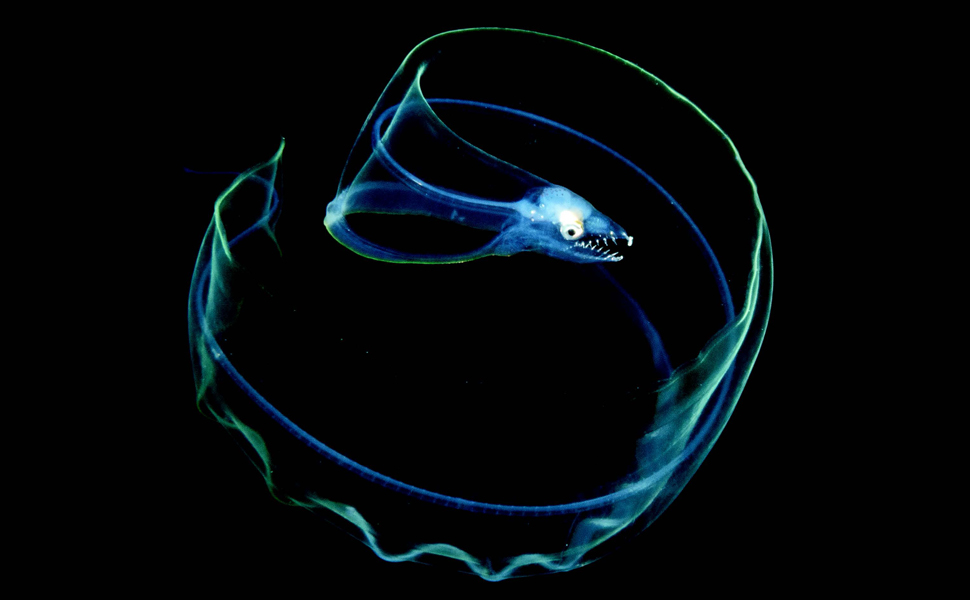

Each part of Strange Sea Creatures explores a different ecosystem and features species from various marine animal groups: fishes, crustaceans, cnidarians, cephalopods, tunicates and many more. Informative captions accompany 90 gorgeous photographs of these otherworldly creatures.
Part 1 The Blackwater Vertical Migrators
Surface Waters of the Ocean at Night
In images taken by dedicated blackwater divers, these mostly larval creatures haunt the near-surface waters, making vertical migrations every night to feed.
Part 2 Masters of the Language of Light
Shallow to Deep Dark Waters
In the ocean’s perpetual night, survival is a matter of being able to understand and process light signals—some in different colors, some flashing, some faint. The animals in this section exhibit the most sophisticated use of bioluminescence on Earth. The sea creatures here are small with big eyes and even larger mouths.
Part 3 The Bottom Dwellers
The Continental Shelf to the Abyssal Plain
The bottom of the sea has fewer fish and is populated by such alien-like creatures as no-eyed sea cucumbers, basket stars, crabs and worms.


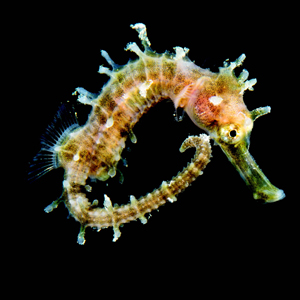

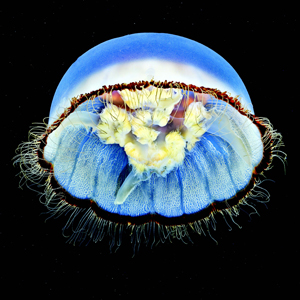
 Cleaner Shrimp
Cleaner Shrimp Hippolytidae or Lysmatidae, unidentified species
This planktonic larva, less than an inch (2 cm) long, comes to within 30 feet (9 m) of the surface at night. When it becomes an adult, it settles on the ocean bottom which, in this case, is up to 600 feet (180 m) below the surface of the ocean off southeast Florida at the edge of the Gulf Stream. Exact identification is difficult as few scientists currently work on shrimp larvae.
Lined SeahorseHippocampus erectus
Juvenile seahorses swim through the forests of Sargassum seaweed in the Gulf Stream off Florida, attaching themselves to the seaweed to ride the currents. This 1 3/4 inch (4.5 cm) young seahorse won’t undertake vertical migrations but as a poor swimmer will spend day and night in the Sargassum.
Brown-banded Moon JellyfishAurelia limbata
This fast, muscular jellyfish, measuring 15 ¾ inches (40 cm) in diameter, was photographed near the Kamchatka shore in the western North Pacific. It lives at depths ranging from close to the surface to 3,300 feet (1,006 m) below the surface. Brown-banded moon jellyfish sometimes gather in dense groups of millions of individuals, devouring all organic material over a huge area. When in large groups they stay still in the water column, spreading their tentacles and oral lobes to feed.
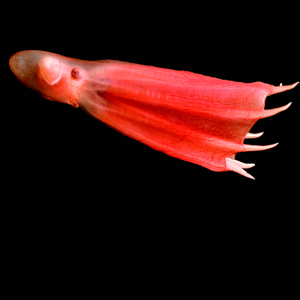

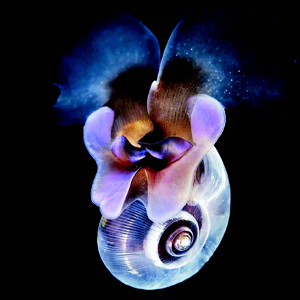

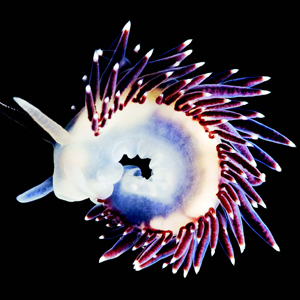
 Dumbo Octopus
Dumbo Octopus Stauroteuthis syrtensis
This little dumbo octopus is only 5 inches (12.5 cm) in diameter. It gets its name because of the two fins that stick out like ears and flap when it swims. The dumbo octopus in this photograph was found 2,700 feet (830 m) below the surface in the Gulf of Maine off the US east coast. It sometimes lives as much as 13,100 feet (4,000 m) below the surface but always stays a few hundred meters above the seafloor.
Sea ButterflyLimacina helicina
This mature sea butterfly, with a shell about 1/2 inch (1.3 cm) wide, looks like a snail waving big, dark earlike wings that appear to be growing out of its mouth. These wings evolved from the crawling foot of its gastropod ancestors. Sea butterflies live in open ocean Arctic waters where they sometimes comprise more than half of the zooplankton abundance. They serve as a main food for many marine species from sea angels to huge whales.
Sea SlugFlabellina verrucosa
This shell-less marine sea slug, less than 1 inch (2 cm) long, was found near the bottom of the White Sea in Russia. Sea slugs often have bright colors to deter predators. Like all species in the class of gastropods, they have tiny razor-sharp teeth. Most sea slugs have two pairs of tentacles on their head that are used primarily for smell as well as a small eye at the base of each tentacle. The protruding structures on their backs, called cerata, act as gills. This sea slug uses its ability to incorporate stinging nematocytes, stolen from its jellyfish and cnidarian prey, which are kept in little white sacs on the end of its cerata as a defence against certain fish and seastar predators.
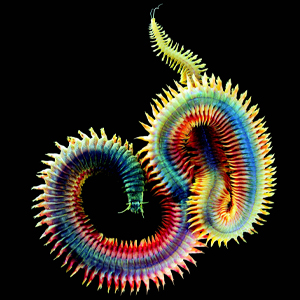

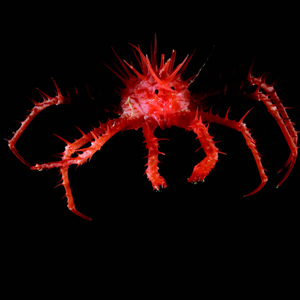

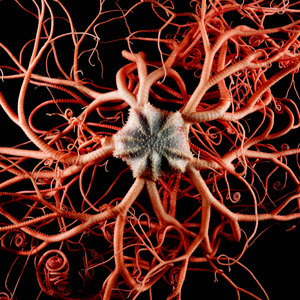
 King Ragworm
King Ragworm Alitta virens
This king ragworm, a kind of annelid worm related to land-based earthworms, lives in the White Sea and measures about one foot (30 cm) long. A mature ragworm can reach 20 inches (50 cm) in length. King ragworms burrow into the sand or sediment, or hide under stones at about 33 to 49 feet (10 to 15 m) below the surface. They emerge to snatch small worms, mollusks and crustaceans, striking snake-like with their two teeth and bringing the prey back into the safety of their burrow. They also scavenge for whatever is available and even eat algae. King ragworms recognize chemical signals from other members of their species which are thought to serve as a warning that active predators are nearby and that they should stay in their burrow.
Porcupine CrabNeolithodes grimaldii
The porcupine crab, a species of king crab, is covered from head to foot in long spines and has a leg span that can reach 40 inches (1 m) across. This one was collected from the Mid-Atlantic Ridge. The species is widely distributed on the bottom of the sea along the continental slope and abyssal plain as well as on deep-sea ridges in both the western and eastern North Atlantic. It has been recorded at depths of up to 17,159 feet (5,230 m) below the surface.
Deepsea Basket StarGorgonocephalus lamarckii
This deep-sea basket star, less than 2 inches (5 cm) across, was found in the North Atlantic off Iceland. It has five arms that branch out dividing repeatedly to create branchlets. To feed, this basket star perches in an elevated position on the bottom 500 to 3,300 feet (150 to 1,000 m) deep, extending its arms in a basket-like fashion. The branches and branchlets twist and coil, capturing small crustaceans that approach too close. The arms are covered in tiny hooks to grasp the prey. Along with the tube feet, these arms bring food to the mouth, located on the underside of the central disc.
Publisher : Firefly Books (October 30, 2020)
Language : English
Hardcover : 112 pages
ISBN-10 : 0228102979
ISBN-13 : 978-0228102977
Item Weight : 1.78 pounds
Dimensions : 10.25 x 0.75 x 10 inches
[ad_2]


I like this website it’s a master piece! Glad I noticed this ohttps://69v.topn google.Raise your business